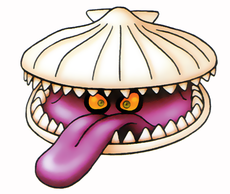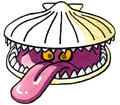Morphean mollusc: Difference between revisions
From Dragon Quest Wiki
No edit summary |
|||
| Line 114: | Line 114: | ||
==Etymology== | ==Etymology== | ||
This monster's Japanese name, たまてがい ''tamategai'' is possibly a play on words of the 玉手箱 ''[https://en.wikipedia.org/wiki/Tamatebako tamatebako]'' from the famous Japanese fairy tale | This monster's Japanese name, たまてがい ''tamategai'' is possibly a play on words of the 玉手箱 ''[https://en.wikipedia.org/wiki/Tamatebako tamatebako]'' from the famous Japanese fairy tale [https://en.wikipedia.org/wiki/Urashima_Tar%C5%8D Urashima Tarō]. | ||
The "bako" (hako before [https://en.wikipedia.org/wiki/Rendaku "rendaku"]) in tamatebako means "box", while the "gai" (kai before rendaku) in "tamategai" means "clam". The "tamate" is two seperate words, with "tama" meaning jewel and "te" meaning hand, which would literally mean "tamate" translates to "Jewel Hand", but the words aren't agreed to impart any special meaning in this context, and might be merely phonetic. | The "bako" (hako before [https://en.wikipedia.org/wiki/Rendaku "rendaku"]) in tamatebako means "box", while the "gai" (kai before rendaku) in "tamategai" means "clam". The "tamate" is two seperate words, with "tama" meaning jewel and "te" meaning hand, which would literally mean "tamate" translates to "Jewel Hand", but the words aren't agreed to impart any special meaning in this context, and might be merely phonetic. | ||
Revision as of 21:53, 2 June 2020
| Dragon Quest monster | |
|---|---|
| Morphean mollusc | |
Art by Akira Toriyama | |
| Japanese | たまてがい |
| Romaji | tamate-gai |
| First appearance | Dragon Quest V |
| Old localization | Scallopa |
The Morphean mollusc is an aquatic monster that first appeared in Dragon Quest V.
Appearances
Dragon Quest V
| Sprite | HP | MP | Attack | Defense |
| 55 | 0 | 80 | 97 | |
| Agility | Experience | Gold | Tame Rate | |
| 60 | 110 | 47 | N/A | |
| Bestiary No. | 182 |
| Spell(s) | None |
| Skill(s) | Sleep Attack Sweet Breath |
| Location(s) | Ocean |
| Item dropped | Seed of Resilience1⁄64 |
| Evasion | Frizz resistance * | Sizz resistance * | Fire Breath resistance * | |
| 0/64 | 67% | 67% | 67% | |
| Bang resistance * | Crack resistance * | Ice Breath resistance * | Woosh resistance * | |
| 67% | 100% | 100% | 100% | |
| Zap resistance * | Drain Magic resistance * | Whack resistance * | Kamikazee resistance * | |
| 20% | 100% | 67% | 0% | |
| Poof resistance | Poison resistance * | Fuddle resistance | Snooze resistance * | |
| 20% | 0% | 0% | 0% | |
| Dazzle resistance * | Sap resistance * | Fizzle resistance | Stun resistance * | |
| 20% | 0% | 100% | 67% | |
| PS2 model | DS & Mobile sprite |
 |
Dragon Quest Monsters 2
| Sprite | Level cap * | HP growth | MP growth |
| 35 | 6/10 | 4/10 | |
| Strength growth | Resilience growth | Wisdom growth | Agility growth |
| 5/10 | 7/10 | 4/10 | 4/10 |
| Family | Water |
| In-game description | Its shell is tough to open. |
| Abilities | MagicWall, Radiant, Upper |
| Habitat | Canal |
| Breeding chart | RogueWave x Devil family, Mimic |
| Frizz Resistance * | Sizz Resistance * | Fire Breath Resistance * | Bang Resistance * |
| Strong | Strong | Strong | Strong |
| Crack Resistance * | Ice Breath Resistance * | Woosh Resistance * | Rock/Army Resistance * |
| Weak | Weak | Strong | None |
| Water Resistance * | Zap Resistance * | Gigaslash Resistance | Magic Burst Resistance |
| Strong | Weak | Weak | None |
| Drain Magic Resistance * | Whack Resistance * | Kamikazee Resistance * | Poison Resistance * |
| None | Weak | None | Strong |
| Paralysis Resistance * | Fuddle Resistance * | Snooze Resistance * | Dazzle Resistance * |
| Strong | Weak | Strong | Weak |
| Fizzle Resistance | Ban Dance Resistance | Gobstopper Resistance | Stun Resistance * |
| None | Strong | Strong | None |
| Sap Resistance * | Decelerate Resistance * | Curse Resistance | |
| None | Strong | None | |
Related enemies
Gallery
Etymology
This monster's Japanese name, たまてがい tamategai is possibly a play on words of the 玉手箱 tamatebako from the famous Japanese fairy tale Urashima Tarō.
The "bako" (hako before "rendaku") in tamatebako means "box", while the "gai" (kai before rendaku) in "tamategai" means "clam". The "tamate" is two seperate words, with "tama" meaning jewel and "te" meaning hand, which would literally mean "tamate" translates to "Jewel Hand", but the words aren't agreed to impart any special meaning in this context, and might be merely phonetic.




